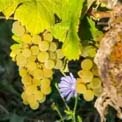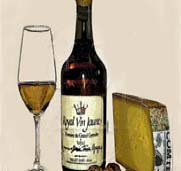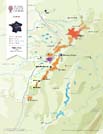Vin Jaune: a yellow wine from the Jura

This is the typical wine for researchers and enthusiasts of rare wines. Vin Jaune, a yellow wine, is the jewel in the Jura winemaking crown. It’s an intense, oxidized wine with a complex flavor, full of dried fruit flavors, yet with excellent freshness and unique depth. It’s not a simple, straightforward wine; like all great oxidized wines, it deserves our full attention.
It requires training the palate and nose, returning to primordial flavors and forgetting the standardized, industrial taste of conventional wine.
We can consider it an immortal wine that can age for up to 20 years. Consider that from 1 liter of wine produced, at the end of the process only 62 cl remain, in the famous, rounded bottle called a clavelin.
The production method closely resembles that of Spanish sherry, and in fact, it is thanks to the mold that develops on the wine—the famous voile, the veil—that the wine ages and oxidizes slowly, without spoiling. But to say that Vin Jaune is a clone of sherry, Marsala, or Vernaccia is nonsense, a barbaric simplification, because like every legendary wine, it has its roots in the blue clays of the Jura, in its tradition and in the culture of fine drinking of this French region. The wines of the Jura are all unmistakably gastronomic beverages; there are no wines to sip to be a hipster; here, cuisine and wine are inextricably intertwined and have been traveling the same path since their inception, like Siamese twins; they are two facets of the same food and wine culture. It’s no coincidence that the recommended, and somewhat predictable, pairing for Vin Jaune is with Bresse chicken, another great local specialty, but it’s also exquisite when paired with truffles, cured meats, and river fish.
How Vin Jaune is produced
It is made from 100% Savagnin, the typical grape of this region, believed to be the ancestor of Gewurztraminer.
The harvest is late, in late October, often after they’ve been attacked by noble rot. They’re then pressed and fermented in wood or stainless steel, then aged in wood, where they often also undergo malolactic fermentation. Maceration on the skins is usually never very long; we’re not talking about an orange wine, even if the color might be misleading. In reality, the amber color is due to prolonged oxidation.
After a few months (up to 18 months), the wine is transferred to used barriques, which are left at least 10 liters full, allowing oxygen to oxidize the liquid. This creates flor, a colony of live mold that transforms the wine while also protecting it from rapid and violent oxidation. This is the secret: the winemaker’s skill and sensitivity, the air, the humidity, and the various positions in which the barrels are stored. Some place them in attics, some in deep cellars, some on the ground floor, although the best results are achieved by blending different aging processes to give the wine greater depth and depth. Once again, we recall the great legends of food and wine, such as Traditional Balsamic Vinegar of Modena, Vin Santo, Sherry, and Marsala—all products that couldn’t be more human, because wine not only embodies the vintage and its characteristics, but also the passing of the seasons, the heat and cold, and the humidity. This is why it’s not an easy wine, but it’s also a masterpiece to fall madly in love with and never be without, because this wine has four dimensions: it has managed to capture and render liquid the passage of time. Remember that aging in under-filled barrels lasts no less than six years, although there are wines that have rested in barrels for decades.
Vin Jaune Production Area
All the Jura appellations produce it: Arbois, Côtes du Jura, Etoile, and of course Château-Chalon, where only this type of wine is produced.
Sensory Characteristics of Vin Jaune
The bouquet is expansive, dominated by dried fruit such as hazelnuts and almonds. The fruit is ripe, yet imbued with austerity. Don’t expect jam or mussels; everything here is subtle, variegated, full of fleeting moments of beauty, citrus, and quinine. It needs plenty of oxygenation in the glass, so don’t open it and drink it immediately. Give it time, wait for it to unfold in all its splendor, and it will reward you with pungent, medicinal, herbaceous aromas of candied fruit and saffron, along with spices and nutmeg, culminating in notes of iodine, honey, and amaretto on the finish. On the palate, it is savory, with almond flavors emerging, with hints of chestnut honey in the background. The structure is never overbearing, but its depth and charisma are unique. The flowers and herbs give texture to the sip, which unfolds and rests on an exhilarating savoriness.
Recommended pairings for Vin Jaune
As mentioned, the classic pairing is Bresse chicken (Bresse chicken: a French gastronomic excellence, Bresse chicken is a high-quality French gastronomic product, known for its high-quality meat and its reputation as “the queen of poultry, the bird of kings.” This chicken is raised in a specific area of France, Bresse, and was awarded the Controlled Designation of Origin (PDO) and the Protected Designation of Origin (AOP) in 1957 and 1996, respectively. The unique characteristics of Bresse chicken include blue legs, white plumage, and a red comb, and its meat is firm and veined, with a very thin, pearly skin. Bresse chicken is recognized for its earthy flavor, which varies from farm to farm, and is sold with a tricolor seal at the base of the neck.) and white meats, but also try it with traditional saucisse de Morteau, as well as the legendary local Comte cheese, and of course with fish, seafood, or smoked duck dishes. Try it with truffle risotto, tagliatelle with ragù, Valdostan fondue, and gnocchi alla romana.


